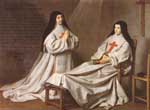

The convent building of Toussaint abbey was built after 1627, at the time of reform Abbot Germain Merceron
St. Charles Borromeo and the Plague in Milan. Chapel, Hospital of St John, ca. 1740
Counter-Reformation in Anjou
The spirit of Counter-reformation and the Council of Trent was brought to Anjou by Bishop Charles Miron (1591-1615). He was a devoté of St Charles Borromeo, whose ideas about church design and reform were apparent in the remodelling of the Cathedral. Images of that saint can be found in more than one Angevin church.

|
 |
The convent building of Toussaint abbey was built after 1627, at the time of reform Abbot Germain Merceron |
St. Charles Borromeo and the Plague in Milan. Chapel, Hospital of St John, ca. 1740 |
The energetic religious spirit of the period is reflected in monasteries of the new orders: Jesuits, Capuchins, and others, sixty-four new foundations in Anjou. Especially important were convents for women, including the Filles de Notre-Dame-de-Charité in the Hospital of St. John. Their chapel was remodelled around 1700, placing a massive baroque altar into the gothic vaulted space. See a view of the chapel.
Reform of the Benedictines took place under the impetus of Maurists. In 1629 they are established in Saint-Serge, in Angers. The Maurists are best known by their services to ecclesiastical and literary history, to patrology, to Biblical studies, to diplomatics, to chronology and to liturgy.
Toussaint Abbey was united with the Congrégation de France headed by the Parisian abbey Sainte-Geneviève. The 17th century convent buildings now serve as the municipal library, and the ruined church itself, magnificently remodelled, is the Galerie David d'Angers.

|
The 1662 Ex Voto by Philippe de Champaigne depicts Mère Angelique Arnaud |
When Henri Arnauld (1649-1692) became Bishop of Angers, he brought to the city the influence of the Jansenist reform movement, in which his family played a leading role. Bishop Henri was heir to the Renaissance tradition of humanist scholarship. His copy of Josephus' Jewish Antiquities is now in the Bibliotheque Mazarin, Paris.
Jansenists were followers of Cornelist Otto Jansen (1585-1638) who based his reform on the teachings of St Augustine, particularly St Augustine's arguments against Pelagius. Pelagius had argued that men can achieve salvation through their actions but Jansen argued that men cannot achieve salvation through their actions since it is predestined who Christ will lead to eternal life, the select few, and who are doomed to damnation, the multitude.
French Jansenists were associated with the convent of Port-Royal, reformed under the guidance of Angelique Arnauld, appointed by a Papal Bull at the age of 11, in the year 1602, to be Abbess of Port Royal. Within a decade, Mère Angelique had completely converted the institution by introducing vows of poverty and seclusion and re-introducing the teaching work of her Abbey after it had long lain idle. About 1636, a remarkable group of men -- physicians, men of letters, soldiers, scholars, and ecclesiasts, influenced by a friend of Port Royal, the Abbe de S. Cyran, took up their residence at Les Grange, near Port Royal des Champs, where they resolved to lead a life of self-renunciation and consecration and took for their rallying cry "Thought allied with faith," making redemption of souls their mission. Among these so-called "Solitaires" were Angelique's brothers Antoine and Henri, as well as Blaise Pascale. They took no vows, but systematically divided their time between religious exercises, literary pursuits, teaching and manual labour. The Jansenist position developed in these years was strongly ascetic and mystical.
Almost from the beginning, the Jansenists aroused the hostility both of the Jesuits, who opposed the theology and moral teachings of the group, and of the French royal government, who associated the Jansenists with the opposition "Devout party" and with the rebellions of the Fronde (1648 - 53). As early as 1653, five propositions supposedly found in the Jansenist position were condemned by Pope Innocent X. In 1713, under intense pressure from King Louis XIV, Pope Clement XI issued the bull Unigenitus condemning 101 propositions in a treatise by another French Jansenist, Pasquier Quesnel (1634 - 1719). The French king closed Port - Royal - des - Champs in 1709 and had it razed to the ground in 1710.
This page was meant to be viewed in frames. |
 Return to Return toAmelia Carr's Home Page |